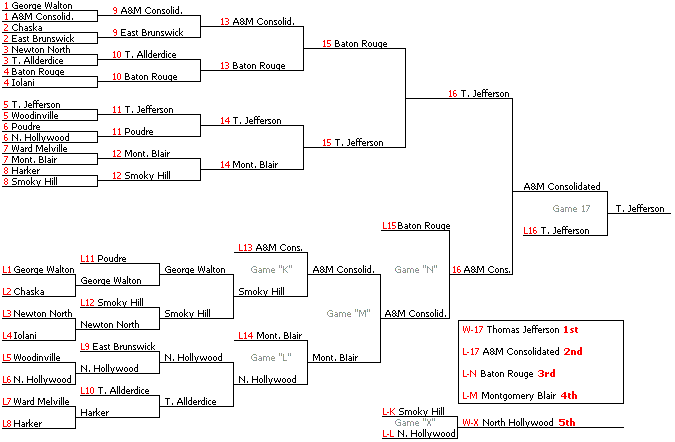Double knock-out
A double knock-out (also double elimination or double knockout system ) is a form of tournament that is based on the knockout system in its basic features , but tries to bypass its weaknesses.
Differentiation from the knock-out system
The double knock-out format essentially differs from the single knock-out system ( single knock-out or single elimination ) in that a one-time defeat does not mean that you are eliminated from the tournament. A participant is only eliminated from the tournament after the second defeat.
Thus a participant can win the tournament despite a one-off loss. In the simple knockout system, this is also ruled out if additional games are held in order to obtain a continuous sequence: the loser of a semi-final game can at best take third place, the loser of a quarter-final game at best fifth, etc.
If two promising participants meet at an early stage of a double knock-out tournament, the loser can still reach the final despite the defeat. Even without betting, it is ensured that the second best player takes second place - provided that the respective favorite actually wins in every match.
example
The implementation of the tournament is more complex than the simple knockout system. Here is an example of a tournament with 16 participants:
Explanation
The tournament schedule is divided in the double k.-o. in two brackets ( Winners Bracket and Losers Bracket or Upper and Lower Bracket , upper and lower half ). After the first round, the winners advance to the next round of the Winners Bracket, and the losers continue to play in the first round of the Losers Bracket. The Winners Bracket is run according to the same method as a simple knockout tournament (for this reason, the number of participants in a double knockout, just like in a single knockout, should be a power of two), except that the losers are not eliminated from the tournament, but continue to play in the Losers Bracket.
The winners bracket is identical to the plan of a simple knockout system until the semifinals.
Each round of the lower bracket is played in two stages:
- In the first stage of the first round, two losers from the first round of the upper bracket meet; In the first stage of each subsequent round, two winners from the previous round meet.
- In the second stage of each round, a winner from the first stage always meets a loser from the same round from the upper bracket.
At the end of the tournament, the winner of the top half meets the winner of the bottom half. This match is often counted as the final. Otherwise the following rule applies: If the participant wins from the upper half, the tournament is over. However, if the participant wins from the lower half, both have lost once and must play against each other a second time; this latter match then decides on places 1 and 2.
In a game after the double k.-o. places 3 and 4 are determined by the order in which they are eliminated; a game for third place is therefore not necessary.
application
This format is often used in tournaments of return games such as badminton , table tennis , squash , volleyball or beach volleyball , windsurfing ( PWA ), but also taekwondo and table football . In tennis , however, the simple knockout system is almost exclusively played.
Number of games
For n teams 2 · ( n - 1) games are played, or one more if the final is repeated as described above. (This formula is also valid if the number of participants is not a power of two. Byes are not counted.)
In the simple knockout system, on the other hand, only n - 1 games are necessary, i.e. exactly half as many; In a round-robin tournament , at least n · ( n - 1) / 2 games would be necessary.
